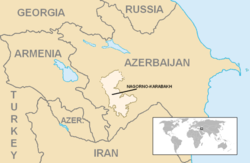นากอร์โน-คาราบัค
นากอร์โน-คาราบัค (อังกฤษ: Nagorno-Karabakh; รัสเซีย: Нагорный Карабах, อักษรโรมัน: Nagorny Karabakh, แปลตรงตัว 'คาราบัคภูเขา'; อาร์มีเนีย: Լեռնային Ղարաբաղ, อักษรโรมัน: Leṙnayin Ġarabaġ, ; อาเซอร์ไบจาน: Dağlıq Qarabağ, หรือ Yuxarı Qarabağ, ) หรือ อัปเปอร์คาราบัค (Upper Karabakh) เป็นภูมิภาคที่ไม่มีทางออกสู่ทะเลในแถบเทือกเขาคอเคซัส ตั้งอยู่ระหว่างภูมิภาคโลเวอร์คาราบัคกับภูมิภาคซียูนิค และครอบคลุมพื้นที่ด้านตะวันออกเฉียงใต้ของทิวเขาเลสเซอร์คอเคซัส พื้นที่ส่วนใหญ่เป็นภูเขาและป่าไม้
นากอร์โน-คาราบัค (อัปเปอร์คาราบัค) | |
|---|---|
 ที่ตั้งและอาณาเขตของอดีตแคว้นปกครองตนเองนากอร์โน-คาราบัค (สีอ่อน) | |
| พื้นที่ | |
• รวม | 4,400 ตารางกิโลเมตร (1,700 ตารางไมล์) |
| น้อยมาก | |
| ประชากร | |
• 2556 ประมาณ | 146,573[1] |
• สำมะโนประชากร 2553 | 141,400[2] |
| 29 ต่อตารางกิโลเมตร (75.1 ต่อตารางไมล์) | |
| เขตเวลา | UTC+4 |
• ฤดูร้อน (เวลาออมแสง) | +5 |
นากอร์โน-คาราบัคเป็นดินแดนที่มีข้อพิพาทเกี่ยวกับอำนาจอธิปไตย โดยนานาชาติยอมรับว่าภูมิภาคนี้เป็นส่วนหนึ่งของอาเซอร์ไบจาน[3] แต่ในปัจจุบัน พื้นที่ส่วนใหญ่ของภูมิภาคอยู่ภายใต้การปกครองของสาธารณรัฐอาร์ทซัค รัฐเอกราช "โดยพฤตินัย" ซึ่งมีกลุ่มชาติพันธุ์อาร์มีเนียอาศัยอยู่และได้รับการสถาปนาขึ้นบนพื้นที่ของ (อดีต) แคว้นปกครองตนเองนากอร์โน-คาราบัคของสาธารณรัฐสังคมนิยมโซเวียตอาเซอร์ไบจาน อาเซอร์ไบจานไม่ได้ใช้อำนาจทางการเมืองในภูมิภาคนี้นับตั้งแต่การกำเนิดขบวนการคาราบัคในปี พ.ศ. 2531 หลังจากที่สงครามนากอร์โน-คาราบัคสิ้นสุดลงในปี พ.ศ. 2537 ตัวแทนจากรัฐบาลอาร์มีเนียและรัฐบาลอาเซอร์ไบจานได้จัดการเจรจาสันติภาพว่าด้วยสถานะที่ยังเป็นที่โต้แย้งของนากอร์โน-คาราบัค โดยมีกลุ่มมินสค์ขององค์การเพื่อความมั่นคงและความร่วมมือในยุโรปเป็นผู้คอยไกล่เกลี่ย
ภูมิภาคนากอร์โน-คาราบัคมีขอบเขตการปกครองเดียวกับแคว้นปกครองตนเองนากอร์โน-คาราบัคในสมัยสหภาพโซเวียต โดยมีเนื้อที่ประมาณ 4,400 ตารางกิโลเมตร (1,700 ตารางไมล์) อย่างไรก็ตาม พื้นที่ทางประวัติศาสตร์ของภูมิภาคนี้ครอบคลุมเนื้อที่ประมาณ 8,223 ตารางกิโลเมตร (3,175 ตารางไมล์)[4][5]
อ้างอิง
แก้- ↑ "Population of NKR as of 01.01.2013". NKR. 1 January 2013. คลังข้อมูลเก่าเก็บจากแหล่งเดิมเมื่อ 2019-10-23. สืบค้นเมื่อ 20 February 2014.
- ↑ "Official Statistics of the NKR. Official site of the President of the NKR". President.nkr.am. 1 January 2010. สืบค้นเมื่อ 6 May 2012.
- ↑ "General Assembly adopts resolution reaffirming territorial integrity of Azerbaijan, demanding withdrawal of all Armenian forces". United Nations. 14 March 2008. สืบค้นเมื่อ 30 Aug 2015.
- ↑ Robert H. Hewsen. "The Meliks of Eastern Armenia: A Preliminary Study". Revue des études Arméniennes. NS: IX, 1972, pp. 288.
- ↑ Robert H. Hewsen, Armenia: A Historical Atlas. The University of Chicago Press, 2001, p. 264. ISBN 978-0-226-33228-4
- Ali; Ekinciel (1 August 2015). Karabakh Diary (1 ed.). Russia: Sage. ISBN 9786059932196. คลังข้อมูลเก่าเก็บจากแหล่งเดิมเมื่อ 2021-03-02. สืบค้นเมื่อ 2022-05-26.
แหล่งข้อมูลอื่น
แก้- Articles and Photography on Artsakh (Nagorno-Karabakh) from UK Photojournalist Russell Pollard
- All UN Security Council resolutions on Nagorno-Karabakh, courtesy U.S. State department
- Nagorno-Karabakh Agreement of 2 November 2008 and country profile from BBC News Online
- Article on the 10 December Referendum from Russia Profile
- The conflict over the Nagorno-Karabakh region dealt with by the OSCE Minsk Conference — Report by rapporteur David Atkinson presented to Political Affairs Committee of the Parliamentary Assembly of the Council of Europe
- Conciliation Resources – Accord issue: The limits of leadership – Elites and societies in the Nagorny Karabakh peace process also key texts & agreements and chronology (in English & Russian)
- Independence of Kosovo and the Nagorno-Karabakh Issue เก็บถาวร 2016-03-03 ที่ เวย์แบ็กแมชชีน
- Interview with Thomas De Waal
- Radio Free Europe / Radio Liberty. Nagorno-Karabakh: Timeline Of The Long Road To Peace
- Resolution #1416 from the Parliamentary Assembly of the Council of Europe
- USIP — Nagorno-Karabakh Searching for a Solution: Key points, by Patricia Carley, Publication of the United States Institute of Peace (USIP)
- USIP — Sovereignty after Empire Self-Determination Movements in the Former Soviet Union. Case Studies: Nagorno-Karabakh. by Galina Starovoitova, Publication of the United States Institute of Peace (USIP)
- Photo Series Nagorno-Karabakh 2008–2011 – daily life, front line, mine clearance, culture, religion.